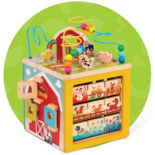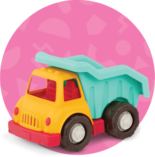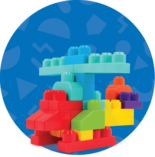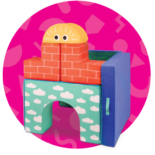For babies, the world is a big mystery—a million-piece puzzle to be solved by their curiosity! Little ones learn about the world around them through their senses: touch, smell, taste, sight, and hearing. Sensory play, or activities that engage children’s senses, boosts sensory development by providing opportunities for learning! If that wasn’t enough, sensory play also improves skills in other key developmental areas—here are 3 additional reasons why integrating sensory play into your child’s day makes total sense!
1. Motor Skills
As little ones touch and feel different objects and textures during sensory play, they’re learning about the world around them through their sense of touch—but that’s not all! As they do so, they’re also developing their motor skills. For example, playing in the sand can boost kids’ tactile development while developing gross motor skills. They’ll be able to feel the grainy texture of sand as they crawl, walk, or run on it! Playing with our Count & Sort Cube is another great sensory activity—it allows kiddos to explore the hard and smooth texture of wood while improving their fine motor skills! Grasping onto the blocks and inserting them into the shape sorter can help them build strength and control in their hand and finger muscles. Bonus! They’ll also be synchronizing hand and eye movements, which helps to develop their hand-eye coordination!
2. Language Skills
Sensory play is a great opportunity for kiddos to expand their vocabulary! As your child’s senses develop, teach them the words they’ll need to describe and share their new experiences. Try using a brightly colored toy, like the Stacking Rings in our Shape Sorter Cube + Stacking Rings Duo, to teach your little one colors. Start the learning early—babies can start to see a full range of color at around 4 months! Begin by sitting next to them and calling out colors as they play, then ask them to name colors themselves when they get older. Or, during a summer day at the beach, get involved in playtime and create opportunities for learning new words. As your child plays, you could describe the texture of sand, the sound of rolling waves, and the smell of beach air. Then, it’s your kiddo’s turn! Ask them to describe what they see, hear, smell, and touch. They’ll get a hands-on vocabulary lesson on temperatures, textures, sounds, and scents while having a blast.
3. Probem-solving Skills
As your child attempts to accomplish a goal during sensory play, they might hit a few bumps in the road! Allow your child to come up with solutions to obstacles for a little problem-solving practice. Maybe they’ll want to build the tallest sandcastle on the beach or transport all 10 of our colorful Stackin’ Boats across the bathtub! Using and arranging objects in different ways to solve problems will not only exercise their creative thinking skills but can also help your child learn more about the properties of water and sand. For instance, they can observe how wet sand differs from dry sand, and how water moves differently around a single boat as opposed to 10 connected together.
What are your kiddo’s favorite sensory activities? Let us know @battattoys!






